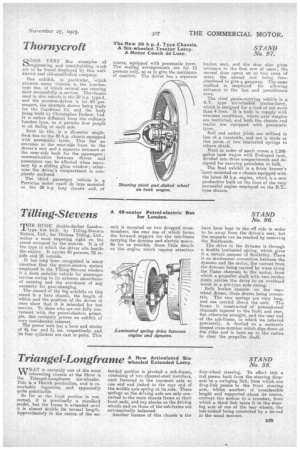Tilling-Stevens
Page 33

If you've noticed an error in this article please click here to report it so we can fix it.
A 48-seater Petrol-electric Bus for London.
STAND No. 96.
rpHE HUGE double-decker London_L type bus built by Tilling-Stevens Motors, Ltd., for Thomas Tilling, Ltd., makes a most imposing sight on the stand occupied by the makers. It is of the type in which the driver sits beside the engine. It carries 48 persons, 22 inside and 26 outside.
• It, has long been recognized in many quarters that, the petrol-electric system employed in the Tilling-Stevens renders it a most suitable vehicle for passenger service owing to its extreme smoothness of running and the avoidance of any necessity for gear-changing.
The second of the big exhibits on this stand is a bare chassis, the length of -which and the position of the driver at, once show that it is intended for bus 'service. To those who are not fully conversant with the petrol-electric principle, this certainly proves an exhibit of very considerable interest..
The power unit has a bore and stroke of 44 ins. and 51ins, respectively, and its four cylinders are east in pairs. This unit is mounted on two dropped crossmembers, the rear one of which forms the forward support for the sub-frame carrying the dynamo and electric motor. So far as possible, those little details on the engine which require attention have been kept to the off side in order to be away from the driver's seat, but the magneto can be reached by removing thefloorboards.
The drive to the dynamo is through a. double laminated spring, which gives it, a certain amount of flexibility. There is no mechanical connection between the dynamo and the motor, the current from the dynamo being carried' by wires along the frame channels to the motor, from which a propeller shaft with two cardan joints carries the drive to an overhead' worm in a pot-type axle easing. Both brakes operate on the rearwheel drums, these drums being concentric. The rear springs are very long, and are carried above the axle. The frame i3 constructed of pressed-steel channels tapered to the front and rear, but otherwise straight, and the rear end of the sub-frame, to which we referred previously, is Mrried on a curiously shaped cross-member which dips down at the sides and is bent up in the centre to clear the propeller shaft.








































































